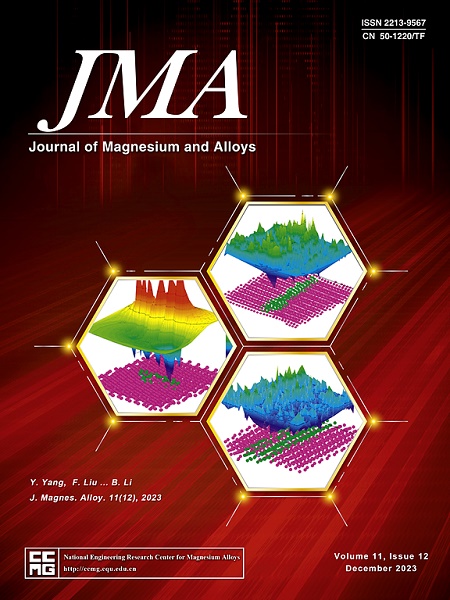Effect of copper addition on precipitation behaviors and mechanical properties of Mg-Zn-Cu alloys with respect to high zinc
IF 15.8
1区 材料科学
Q1 METALLURGY & METALLURGICAL ENGINEERING
引用次数: 0
Abstract
The current work deals with the precipitation behaviors and mechanical properties of the high zinc content of the Mg-Zn-Cu system alloys using gravity casting. Differential scanning calorimetry (DSC) was conducted to describe the solidification process and precipitation behaviors. Thermodynamic calculations were carried out to determine the precipitation conditions using the Thermo-calc software. The microstructures were characterized by an optical microscope (OM), scanning electron microscope (SEM), electron probe micro analysis (EPMA), transmission electron microscopy (TEM), and confocal laser scanning microscope (CLSM). Tensile tests and micro-hardness tests were applied to investigate the mechanical properties. The results substantiated that the MgZnCu phase precipitates in Cu-containing alloys and that the precipitate content, as well as the precipitate temperature, increased with the Cu content from 0 to 3 wt.% according to the thermodynamic calculations and the DSC results. The measured micro-hardness of the alloy was 53.2, 57.9, 55.8, and 52.5 VHN, respectively. The ultimate tensile strength (UTS), yield strength (YS), and elongation (EL) revealed a λ-like trend of the alloys, and Mg-7Zn-1Cu alloy exhibits the optimum tensile properties with the UTS of 258.9 MPa, YS of 126.2 MPa, and the EL of 14.2%.
添加铜对高锌镁锌铜合金沉淀行为和机械性能的影响
目前的研究工作涉及使用重力铸造的高锌含量镁锌铜合金的析出行为和机械性能。采用差示扫描量热法(DSC)来描述凝固过程和析出行为。使用 Thermo-calc 软件进行了热力学计算,以确定沉淀条件。光学显微镜(OM)、扫描电子显微镜(SEM)、电子探针显微分析(EPMA)、透射电子显微镜(TEM)和激光共聚焦扫描显微镜(CLSM)对微观结构进行了表征。拉伸试验和显微硬度试验用于研究其机械性能。结果证实,根据热力学计算和 DSC 结果,在含铜合金中会析出 MgZnCu 相,且析出物含量和析出物温度会随着铜含量从 0 wt.% 到 3 wt.% 的增加而增加。测得的合金显微硬度分别为 53.2、57.9、55.8 和 52.5 VHN。合金的极限拉伸强度(UTS)、屈服强度(YS)和伸长率(EL)呈现出类似于 λ 的趋势,Mg-7Zn-1Cu 合金的拉伸性能最佳,UTS 为 258.9 MPa,YS 为 126.2 MPa,EL 为 14.2%。
本文章由计算机程序翻译,如有差异,请以英文原文为准。
求助全文
约1分钟内获得全文
求助全文
来源期刊

Journal of Magnesium and Alloys
Engineering-Mechanics of Materials
CiteScore
20.20
自引率
14.80%
发文量
52
审稿时长
59 days
期刊介绍:
The Journal of Magnesium and Alloys serves as a global platform for both theoretical and experimental studies in magnesium science and engineering. It welcomes submissions investigating various scientific and engineering factors impacting the metallurgy, processing, microstructure, properties, and applications of magnesium and alloys. The journal covers all aspects of magnesium and alloy research, including raw materials, alloy casting, extrusion and deformation, corrosion and surface treatment, joining and machining, simulation and modeling, microstructure evolution and mechanical properties, new alloy development, magnesium-based composites, bio-materials and energy materials, applications, and recycling.
 求助内容:
求助内容: 应助结果提醒方式:
应助结果提醒方式:


